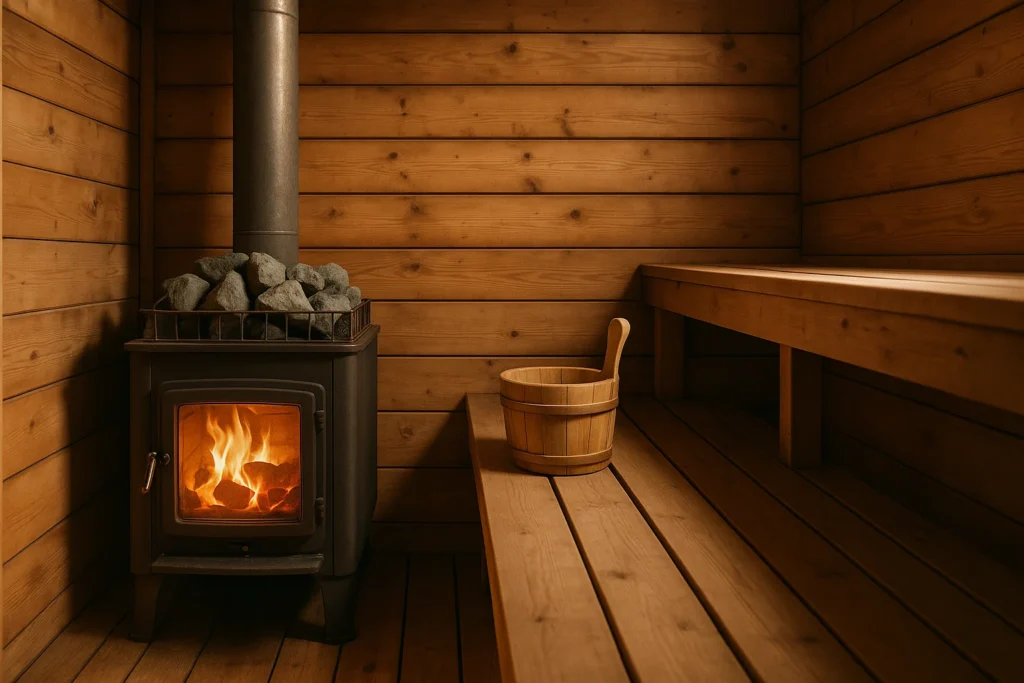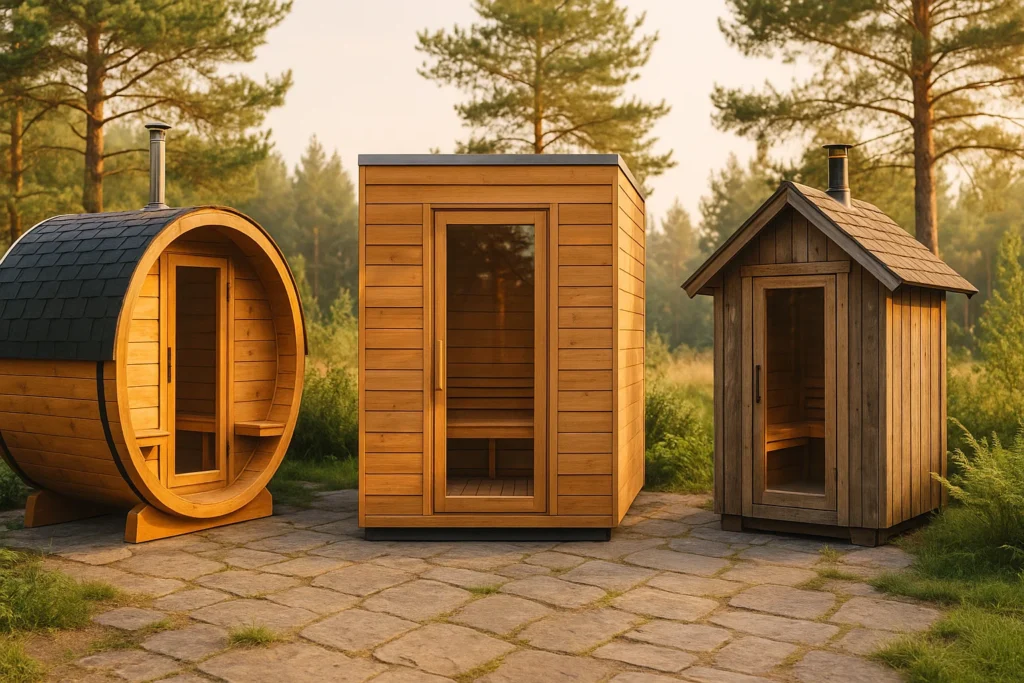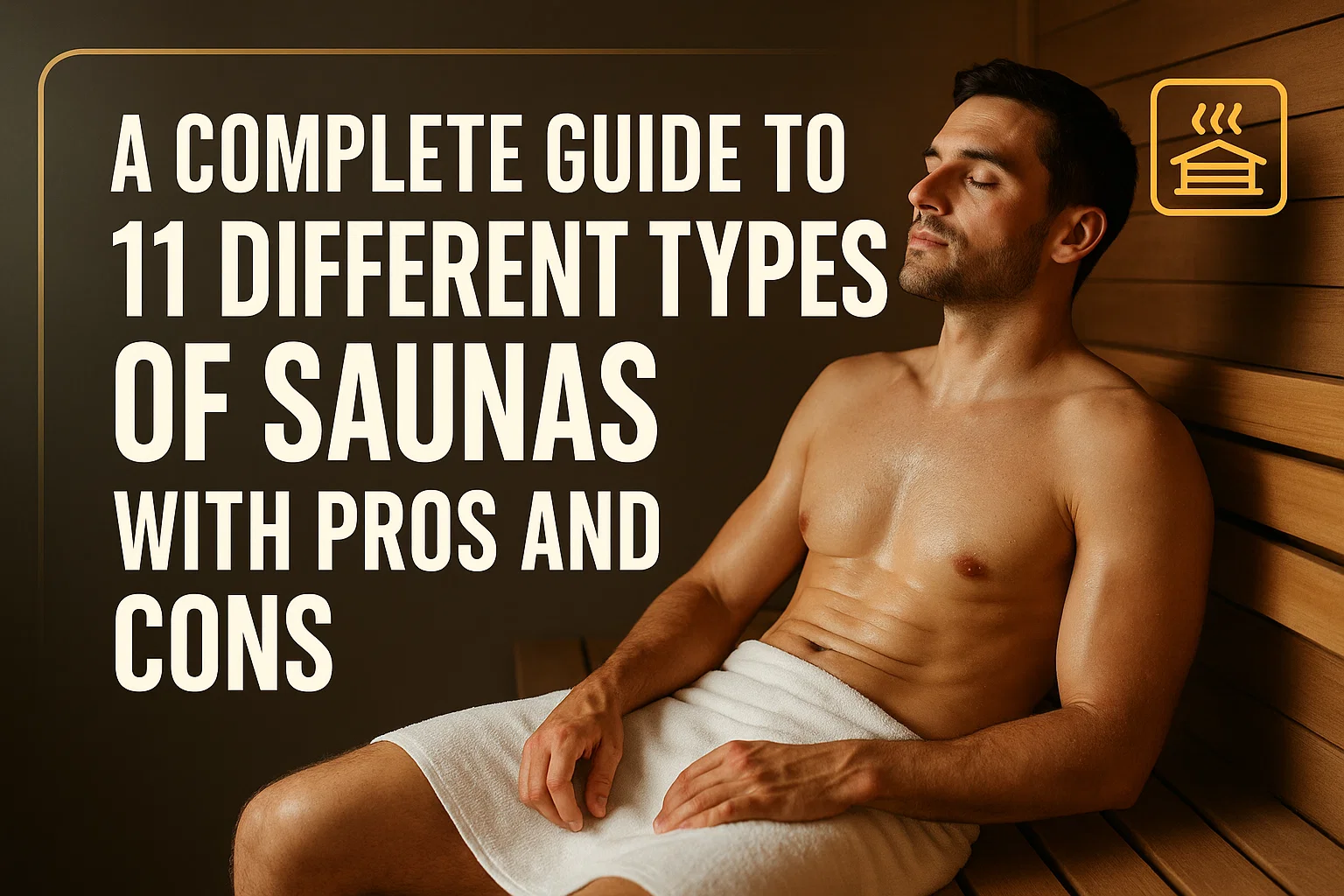Imagining that you have your own place of retreat where stress is washed away with every puff of steam? If you are looking to find out more about your sauna options, whether you want the rustic experience of using a wood burning sauna or the stylish practicality of infrared saunas, understanding the types of saunas is the initial step in creating your own personal outdoor oasis.
Whether it be a cozy cabin-like log sauna, high-tech hybrid, even floating sauna boats, this guide will unpack 11 different outdoor sauna types with pros and cons to help you choose the one that suits your lifestyle, climate and backyard dreams.
Let’s explore the heat and harmony of outdoor saunas and find the one that’s just right for you.
Understanding the Different Types of Outdoor Saunas
Outdoor saunas do not have as much variety as one might think. Some are wood-burning classics, some are portable tents and each provides a different experience.
1. Traditional Wood-Burning Sauna
How It Works
A conventional wood burning sauna uses a wood burning stove to heat heavy sauna stones. Hot stones are then poured on and water poured over it, creating steam and rising humidity and heat.
Features
- Gives a traditional, authentic sauna feeling with a great natural wood scent
- Requires stacking and burning firewood to maintain heat
- The temperature of the air may reach 180°F (82°C) and is high in humidity (steam)
Pros
- Rich, enveloping heat and relaxing atmosphere
- No electricity needed, reducing energy costs
- Traditional and cultural sauna essence
Cons
- Needs continuous wood supply and effort to maintain the fire
- Requires good ventilation to ensure smoke air quality
- Longer heating time; may take 30-60 minutes to reach full heat
2. Log Sauna / Sauna Cabin
How It Works
Made out of thick logs completely or mainly, these saunas are both rustic and very well insulated.
Features
- Log cabin design which is usually constructed out of cedar, spruce, or pine logs
- Thick wooden walls retain heat efficiently
- Are wood or electric heated
Pros
- Super strong and weather proof
- Accumulates more heat to give longer periods in the sauna
- Provides beauty and worth to exterior property
Cons
- Additional outlays at the outset in the form of the material and construction
- Needs a regular check-up to avoid wood rotting or insect attack
- Larger footprint, needing more space
3. Barrel Sauna
How It Works
Barrel saunas are barrel-shaped in form and usually wood. The round design helps to circulate heat fast and evenly.
Features
- Tiny and physically distinctively styled
- Wood-fired, or electric may be employed
- Efficient design warms interior quickly
Pros
- Heats up faster than traditional box saunas
- Space-efficient design perfect for smaller yards
- Natural air circulation inside improves sauna quality
Cons
- Limited interior space may not fit larger groups comfortably
- Requires a flat, level surface for stable installation
- Curved benches can feel tight for some users

4. Cylinder Sauna
How It Works
The barrel sauna is a variation of the barrel sauna but in a long cylindrical shape, giving it a modern and clean finish.
Features
- Contemporary, modern, slim design
- Usually electric- or wood-heated
- In order to have the best heat distribution indoors
Pros
- Easy and trendy
- Efficient heating has even temperature
- Can fit neatly into narrow outdoor spaces
Cons
- Less interior room compared to larger sauna cabins
- May feel cramped for groups
- Custom or specialized construction can be costly
5. Outdoor Infrared/Hybrid Sauna
How It Works
Infrared saunas warm the body with infrared heaters rather than heating air or stones. Hybrid models use infrared with conventional sauna heat.
Features
- Milder ambient temperatures (typically 120°F–140°F)
- Infrared heat goes farther into the muscles
- Electric powered, digital controls
Pros
- Fast heat up time, usually in 10-15 minutes.
- Energy saving and simpler to operate.
- User-friendly for people sensitive to intense heat
- No steam, reducing humidity issues outdoors
Cons
- Lacks the traditional steam and aroma from water on hot stones
- Some sauna enthusiasts may find experience less authentic
- Requires electrical access, adding installation complexity outdoors
6. Sauna Tent
How It Works
A sauna tent is a portable, lightweight outdoor sauna made from thermal fabric and a foldable frame.
Features
- Designed for easy assembly and transport
- Uses electric or infrared heaters inside the tent
- Typically small capacity, ideal for temporary or occasional use
Pros
- Affordable alternative to permanent saunas
- Highly portable and compact for small spaces or travel
- Simple setup, great for beginners or trial saunas
Cons
- Less durable, prone to wear and tear in harsh weather
- Limited heat retention; may require longer heating
- Smaller capacity may not suit families or groups
7. Mobile Sauna
How It Works
Built into trailers, vans, or trucks, mobile saunas offer the flexibility to relocate your sauna anywhere.
Features
- Fully equipped sauna rooms on wheels
- Usually wood or electric heated with seating for a few people
- Popular for events, rentals, or spreading wellness benefits in different places
Pros
- Ultimate flexibility in location and use
- Can bring sauna to remote or unconventional spots
- Great marketing or rental opportunity for businesses
Cons
- Expensive initial investment, custom-built units cost more
- Smaller interior space due to vehicle size constraints
- Requires regulatory compliance for road use and utilities
8. Sauna Boat / Floating Sauna
How It Works
Floating platforms or boat saunas are a unique opportunity to combine the water and heat effects.
Features
- Floating sauna with onboard stove and sitting place on board
- Areas in lakes, rivers, or coastal waters are often placed to be used
- People can take a break by plunging in an adjacent water source
Pros
- Extremely relaxing and unique environment
- Combines benefits of sauna and aquatic cooling
- Iconic, memorable experience for guests
Cons
- High construction and maintenance costs
- Requires specialized knowledge for safe water and electrical installations
- Limited locations suitable for setup

9. Smoke Sauna / Savusauna (Finnish)
How It Works
A Finnish tradition, this sauna uses a wood fire stove without a chimney. Smoke fills the room during heating and is vented before use.
Features
- Unheated stone stove filled with smoke, which simultaneously heats stones
- Distinct smoky aroma and deep heat
- Slow heating over several hours
Pros
- Historic, cultural authenticity prized in Finland
- Provides soft, intense, and dry heat
- Unique smoky fragrance enhances relaxation
Cons
- Complex to operate; requires skill to manage fire and smoke venting
- Long heating and cooling cycles (can take all day)
- Less practical for casual sauna users or frequent use
10. Outdoor Home Sauna
How It Works
Custom-built saunas designed specifically for residential outdoor spaces. These can incorporate any heating type or style.
Features
- Customized to the specifications, size and design preference of the homeowner
- The heaters may use wood-burning, electric, infrared, or hybrid heaters
- They may have facilities such as windows, changing rooms or showers
Pros
- Fully personalized to match your lifestyle and space
- Adds real estate value and luxury appeal
- Can be optimized for efficiency and comfort in your climate
Cons
- Costly project requiring professional installation
- Requires dedicated outdoor space and foundation
- Ongoing maintenance based on materials and heating system
11. Outdoor Finnish Sauna
How It Works
The real Finnish sauna is outside: firewood stove heat, controlled humidity – water poured over the stones.
Features
- Traditional wooden structure, often with cedar, spruce, or pine
- Robust firewood stove heats interior, stones, and air
- High humidity steam option from water
Pros
- Authentic cultural experience with strong health benefits
- Special detox body and mind relaxation
- Long lasting design for outdoors in cold climates
Cons
- Needs skilled stove operation and wood storage
- Requires routine cleaning and sauna wood care
- Heating times can be long compared to electric models
Pros and Cons of Different Outdoor Sauna Types
| Sauna Type | Pros | Cons |
| Wood-Burning | Authentic, natural heat, no electric cost | Requires firewood, longer heating time |
| Log Sauna / Cabin | Durable, good insulation, rustic charm | Maintenance-intensive, costlier |
| Barrel Sauna | Space-efficient, fast heating | Smaller interior space |
| Cylinder Sauna | Stylish, even heat distribution | Less room than traditional cabins |
| Infrared / Hybrid | Quick startup, energy-efficient | No steam, less traditional |
| Sauna Tent | Portable, affordable | Limited durability, heat retention |
| Mobile Sauna | Mobile, versatile location | Expensive, small capacity |
| Sauna Boat / Floating | Unique experience, scenic | High cost, specialized upkeep |
| Smoke Sauna | Historic, unique flavor | Complex, time-consuming |
| Outdoor Home Sauna | Customizable, adds value | High installation and space needs |
| Outdoor Finnish Sauna | Authentic, excellent steam control | Ongoing maintenance and wood supply |
Choosing the Best Outdoor Sauna for Cold Climates
When selecting an outdoor sauna in cold weather environments, look out to have something that is well-insulated with thick wood and double-walled to trap heat. Wood stoves can be used in extreme cold, as they provide strong and long-lasting heat; infrared heaters might not work as well. Make use of tough weatherproof woods such as cedar or spruce to endure difficult weather. To be convenient, electric or hybrid saunas are more convenient in terms of use, and heat faster in cold weather.
Conclusion
An in-depth look at the various types of saunas provides a wide range of choices to select to get healthy, relax and enjoy the outdoors. Modern tents made of infrared and portable materials have a new twist to the traditional wood-burning sauna and there is an outdoor sauna type to suit everyone and every climate. This knowledge of the pros and cons of each will aid you in choosing the best sauna that fits your budget, requirements and the available outdoor area that you have.
To have the perfect sauna experience, tailored to your home or property, trust on All Star Construction Group to help you design, install, and maintain.
FAQ’s
Cleaning: Do basic cleaning after every use and a thorough check up after every 6 to 12 months.
Yes, but make sure that it is weatherproofed and well-set up electrically.
Mobile saunas: These are good when it comes to portability; however, they are more costly and smaller in size.
It utilizes the smoke of a wood fire in a chimney-less stove to warm the sauna, and has an authentic Finnish feel about it with a unique aroma.


